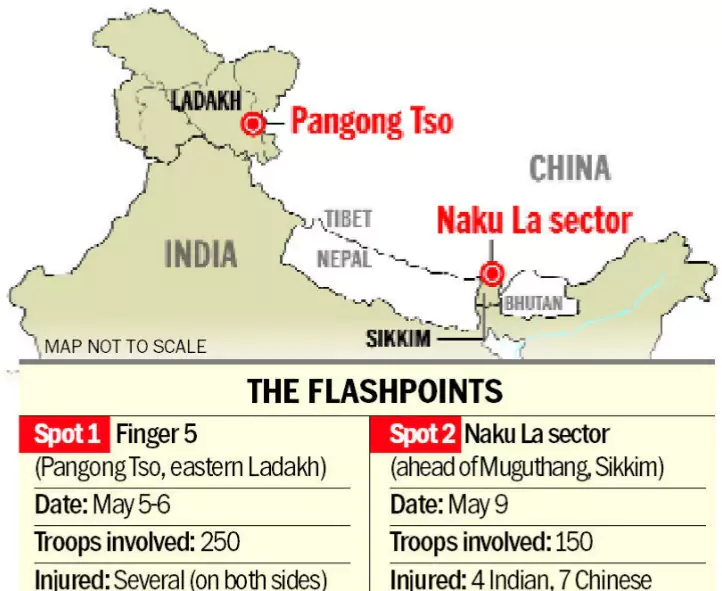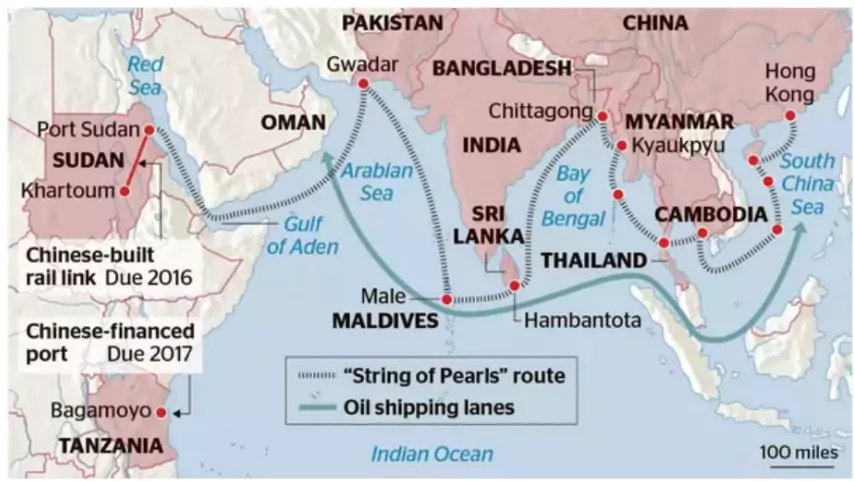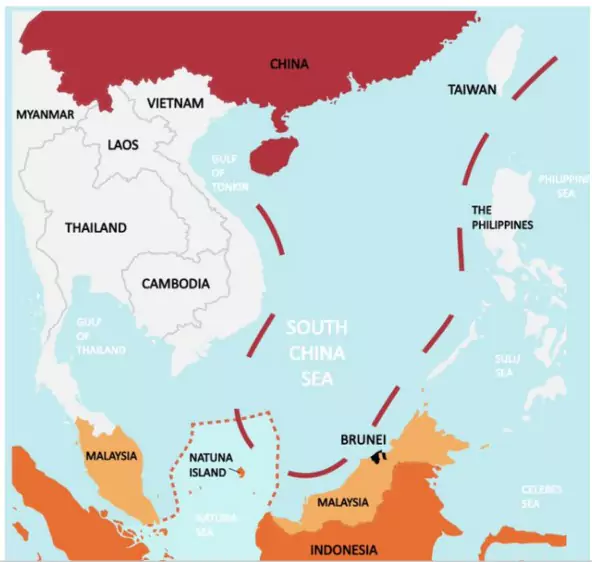The 25th Shanghai Cooperation Organisation (SCO) Summit in Tianjin, China (2025), the biggest so far, showed a small India–China thaw. After 75 years of relations, it brought back focus on Panchsheel, border issues, and economic ties.
About India–China Bilateral Meet at the 25th SCO Summit, Tianjin (2025)
- Symbolic Reset: The first structured India-China bilateral in seven years marked a cautious thaw post-Galwan (2020). Both leaders reframed ties by affirming that India and China are development partners, not rivals, signalling a shift from confrontation to coexistence.
- This meeting reopened long-stalled dialogue channels and signalled willingness to recalibrate ties.
- Border Question & Security: Both sides reaffirmed commitment to peaceful resolution of LAC standoffs through military and diplomatic channels. India stressed that border peace is a prerequisite for stable relations, while China prioritised regional stability without direct reference to disputes.
- The contrast remains—India’s approach is security-first, while China emphasises economics-first.
About Line of Actual Control (LAC)
- The Line of Actual Control (LAC) is the de facto boundary separating India and China, stretching about 3,488 km across Ladakh, Uttarakhand, Himachal Pradesh, Sikkim, and Arunachal Pradesh.
- It is not a formally agreed boundary but a result of differing territorial perceptions.
- Segments of the LAC:
-
- Western Sector (Ladakh, ~1,597 km): Dispute over Aksai Chin; site of Galwan clashes (2020).
- Middle Sector (Uttarakhand, Himachal, ~545 km): Least disputed; limited patrol incidents.
- Eastern Sector (Sikkim, Arunachal, ~1,346 km): China claims Arunachal as “South Tibet”; flashpoints include Doklam standoff (2017).
|
- Panchsheel Revival: The Indian PM recalled the Panchsheel principles (1954) as a guiding framework of sovereignty and peaceful coexistence. The President of China outlined a 4-point plan—trust, communication, cooperation, and safeguarding interests—anchoring ties in shared historical foundations.
- Referencing Panchsheel symbolised a deliberate return to cooperative traditions to ease present frictions.
- Economic Dimensions: Talks acknowledged the $100 bn trade deficit, with discussions on cooperation in renewables, AI, pharmaceuticals, and connectivity. China offered support through SCO’s $1.4 bn loan package and proposed development bank, while India pressed for balanced trade and supply chain resilience.
- Economic engagement was projected as a pathway to stabilise ties despite persistent asymmetry.
- Geopolitical Balancing: India’s SCO pitch—S–C–O = Security, Connectivity, Opportunity —projected its civilisational ethos and soft-power diplomacy. China, by contrast, pushed for bloc integration and financial instruments, using SCO to reinforce its leadership in the Global South.
- The meeting reflected India’s civilisational messaging versus China’s financial statecraft.
- Border Peace Mechanisms: Both sides agreed to strengthen confidence-building measures (CBMs)—hotlines, local-level dialogues, and working groups to maintain LAC stability. While territorial settlement remains distant, these mechanisms help prevent escalation.
- Priority was placed on crisis management over immediate resolution.
- Broader Significance: India used the summit to underline strategic autonomy, avoiding US–China binaries, while China utilised SCO as a platform to display Global South leadership. Both sides agreed on compartmentalising disputes and expanding cooperation in multilateral arenas like SCO, BRICS, and G20.
- Bilateral diplomacy merged with multilateral optics, making SCO a stage for narrative reset.
Panchsheel: The Five Principles
- About: The Panchsheel Agreement, formally known as The Agreement on Trade and Intercourse with Tibet Region, was signed on April 29, 1954, by N Raghavan, the Indian Ambassador to China, and Zhang Han-Fu, China’s Foreign Minister.
- Five Guiding Principles: The preamble of the Panchsheel Treaty lay down five guiding principles:
- Mutual respect for each other’s territorial integrity and sovereignty
- Mutual non-aggression
- Mutual non-interference
- Equality and mutual benefit
- Peaceful co-existence.
- Aim of the Agreement:
- To enhance trade and cooperation between the two countries,
- Establish each country’s trade centres in major cities of the other,
- Lay out a framework for trade,
- The agreement also listed important religious pilgrimages, provisions for pilgrims, and acceptable routes and passes available to them.
- Significance of the Agreement: India for the first time recognised Tibet as the Tibet Region of China.
About the Shanghai Cooperation Organisation (SCO)
- Meaning & Origin: The Shanghai Cooperation Organisation (SCO) is a Eurasian political, economic, and security grouping.
- It originated from the Shanghai Five (1996) — China, Russia, Kazakhstan, Kyrgyzstan, and Tajikistan, which had a mutual security agreement.
- On 15 June 2001, the Shanghai Five along with Uzbekistan formed the SCO as a broader organisation.
- Headquarters: Beijing, China.
- Official Languages: Russian and Chinese.
- Membership Evolution:
- Founding Members (2001): China, Russia, Kazakhstan, Kyrgyzstan, Tajikistan, Uzbekistan.
- Expansion:
- 2017 – India and Pakistan joined.
- 2023 – Iran became a full member.
- 2024 – Belarus became the 10th full member.
- Observers: Afghanistan, Belarus (before full membership), Mongolia.
- Dialogue Partners: 14 states, including Saudi Arabia, Egypt, Myanmar, Qatar, Nepal, Sri Lanka, Cambodia, and Turkiye.
- Scale & Reach:
- SCO member states account for 43% of the world’s population.
- They represent about one-quarter of the global economy.
- Objectives of SCO:
- Ensure regional peace, security, and stability.
- Counter terrorism, extremism, and separatism (via RATS – Regional Anti-Terrorist Structure, Tashkent).
- Promote economic, energy, and technological cooperation.
- Improve connectivity and cultural exchanges across Eurasia.
- Encourage multipolarity in global governance, reducing dependence on Western-led institutions.
- Significance for India:
- Strategic Outreach: Enhances India’s engagement with Central Asia and Eurasia.
- Energy Security: Access to oil, gas, and uranium resources.
- Counter-Terrorism: Platform for cooperation against cross-border terrorism.
- Balancing China: Opportunity to deepen ties with Russia and Central Asia.
- Soft Power Diplomacy: Promotes cultural linkages and civilizational dialogue.
|
About India-China Relations
- Historical Evolution: Panchsheel to Present
-
- Panchsheel Agreement (1954): Signed by Nehru and Zhou Enlai on trade with Tibet; principles of sovereignty, equality, non-aggression, non-interference, and peaceful coexistence became cornerstones of NAM and UN diplomacy.
- Bandung (1955) and NAM (1961): Panchsheel integrated into global discourse as a moral framework for newly independent nations.
- 1962 War & Aftermath: India–China trust broke down; relations fluctuated between conflict (1962, Doklam 2017, Galwan 2020) and cooperation (BRICS, SCO).
- 75 Years of Relations: Defined by strategic distrust but pragmatic engagement—India seeks strategic autonomy, while China projects multipolar leadership.
Background of India- China Border Disputes
- Proposal for MacMohan Line (1913-14): Simla Conference aimed to establish a boundary between British India and Tibet.
- McMahon Line was proposed, which was an 890-km boundary extending from Bhutan to Burma but was not accepted by China.
- Annexation of Tibet (1950): China’s annexation of Tibet created one of the longest undemarcated borders of the world.
- Introduction of Line of Actual Control (LAC) (1959): China proposed LAC as a boundary between the two nations. India rejected this proposal.
- LAC is divided into three sectors: the eastern sector which spans Arunachal Pradesh and Sikkim, the middle sector in Uttarakhand and Himachal Pradesh, and the western sector in Ladakh.
- Sino-Indian War (1962): on November 21, 1962, China declared a ceasefire in its war with India, with China seizing territory in Aksai Chin.
- Ceasefire and Aftermath: China declared a ceasefire, withdrawing from most invaded areas but retaining control over Aksai Chin.
- Establishment of LAC: The LAC became an informal ceasefire line, but disputes persisted as both countries interpreted it differently.
- Ongoing Disputes: The McMahon Line is India’s interpretation of the LAC while China claims Aksai Chin and Arunachal Pradesh, which it refers to as ‘South Tibet’, as its territory.
|
India-China Bilateral Ties
- Political: On 1 April, 1950, India became the first non-socialist bloc country to establish diplomatic relations with the People’s Republic of China.
- Economic Ties (2025): Bilateral trade reached US$127.7 billion, making China India’s second-largest trading partner after the U.S.
- Imports from China: Valued at US$113.5 billion, rising 11–15% YoY, led by electronics, EV batteries, solar cells, and industrial inputs.
- Exports to China: Declined to US$14.3 billion, a 14–15% fall from the previous year.
- Trade Deficit: Hit a record US$99.2 billion, reflecting structural imbalance and India’s high dependence on Chinese imports.
- Cultural: India and China have a history of cultural exchanges and have established institutions like the Yoga College in China.
- Education: India and China signed the Education Exchange Programme (EEP) in 2006 under which government scholarships are awarded to 25 students, by both sides in recognized institutions of higher learning in each other’s country.
- Multilateral cooperation: India and China continue high-level engagement at regional fora such as the Shanghai Cooperation Organisation (SCO) and BRICS groupings reflecting common agenda for growth and development.
- Informal Summits: Both countries have jointly advocated the Five Principles of Peaceful Coexistence.
- Both countries have initiated the “hometown diplomacy”, held two informal summits in Wuhan and Chennai respectively.
Challenges Associated with India-China Relations

- Five Finger Policy: Both countries share around 3,488 km-long Line of Actual Control (LAC) that runs along the Himalayan region, much of it poorly demarcated.
- China considers Tibet to be the right hand’s palm of China with Ladakh, Nepal, Sikkim, Bhutan and NEFA (Arunachal Pradesh) as its five fingers.
- An estimated 50,000-60,000 troops have been posted on either side of the India-China border in eastern Ladakh.
- Salami Slicing Strategy: Sino-Indian border skirmishes are a part of China’s larger “Salami Slicing Strategy”, wherein China is undertaking small geopolitically unlawful steps to achieve a larger gain which would have been otherwise impossible to carry out all at once.
- China has been consistently building infrastructure in border areas including roads, bridges and model villages etc.
- For instance, China has constructed around 628 well-off villages along India’s borders with the Tibet Autonomous Region, understood as dual-use infrastructure for both civil and military purposes.
- Belt and Road Initiative(BRI): India opposes China’s BRI, as it violates India’s sovereignty and territorial integrity, as the China-Pakistan Economic Corridor passes through parts of the Pakistan occupied Indian state of Jammu & Kashmir.
- Aggressive Policies in the Neighbourhood: Building ports and naval facilities under String of Pearls would encircle India which would allow China to influence and control key maritime routes in the Indian Ocean.
 String of Pearls is a geopolitical and geostrategic initiative which includes a network of Chinese military and commercial facilities which extend from the Chinese mainland to Port Sudan in the Horn of Africa. Ex- Hambantota port.
String of Pearls is a geopolitical and geostrategic initiative which includes a network of Chinese military and commercial facilities which extend from the Chinese mainland to Port Sudan in the Horn of Africa. Ex- Hambantota port.
- Debt Trap Diplomacy: China’s “Debt Trap Diplomacy” influences India’s relations with other countries like Maldives, Sri Lanka, Myanmar and Nepal, thereby hindering India’s neighbourhood first policy.
- Recent change in Maldives’ stance towards India, setting a deadline for withdrawal of Indian troops from Maldives, is a consequence of its growing proximity to China.
- India’s Import Dependency: India sources over 14% of its imports from China, mainly electronics, APIs, solar modules, and chemicals, creating a record US$99.2 bn trade deficit and supply chain risks despite diversification efforts.
 Water Dispute: No formal treaty has been established for the sharing of the Brahmaputra River water has been a significant source of tension with China constructing numerous dams in the upper reaches of the river on which India has raised objections.
Water Dispute: No formal treaty has been established for the sharing of the Brahmaputra River water has been a significant source of tension with China constructing numerous dams in the upper reaches of the river on which India has raised objections.- South China Sea (SCS)and India: China claims sovereignty over part of the SCS, via the 9 dash line and its illegal creation/militarisation of artificial islands in the SCS.
- China’s “Nine-Dash Line” refers to a demarcation line used by the People’s Republic of China to assert its territorial claims in the South China Sea.
- China recently voiced objection to Vietnam’s invitation for India to invest in the oil and natural gas sector in the contested SCS.
PWOnlyIAS Extra Edge:
Significance of Stable India–China Relations
- Border Peace & Security: Stability ensures fewer clashes on the Line of Actual Control (LAC), enabling both nations to prioritise development over militarisation.
- Economic Growth: Smooth ties boost bilateral trade (>$100 bn) and strengthen global supply chains, helping India manage its import dependencies.
- Regional Stability: Cooperation prevents smaller South Asian nations from becoming arenas of rivalry, reducing external power interventions.
- Multilateral Cooperation: Joint participation in SCO, BRICS, and G20 amplifies the Global South’s voice in global governance.
- Counter-Terrorism: Coordinated efforts enhance security frameworks and reduce threats of cross-border terrorism.
- Energy & Connectivity: Stable relations allow collaboration on regional corridors and energy projects, cutting reliance on distant suppliers.
- Climate & Global Issues: As top carbon emitters, joint climate initiatives improve sustainability and global negotiations.
- Cultural Exchanges: Stability fosters education, tourism, and cultural links, reviving centuries-old civilisational ties.
- Strategic Balance: Peaceful ties prevent an arms race in Asia and reinforce multipolarity in international relations.
- Future of Asia: As rising powers, their relations will shape Asia’s path—towards conflict or cooperative prosperity.
|
India’s Efforts to Counter Chinese Influence
- Strategic and Security Measures:
- Border Defence: Strengthened military presence along the Line of Actual Control (LAC) post-Galwan clash (2020); accelerated construction of roads, bridges, and tunnels in border areas.
- Quadrilateral Security Dialogue (Quad) & Indo-Pacific Strategy: Deepening cooperation with the United States, Japan, and Australia to balance China’s assertiveness.
- Defence Partnerships: Expanded defence cooperation with France, Russia, and Association of Southeast Asian Nations (ASEAN); strengthening joint military exercises like Malabar Naval Exercise.
- Economic and Trade Responses:
- Self-Reliance Initiatives (Atmanirbhar Bharat) and Production Linked Incentive (PLI) Schemes: Reducing reliance on Chinese imports, particularly in electronics, telecommunications, and pharmaceuticals (where dependency on Key Starting Materials exceeds 50%).
- Foreign Direct Investment (FDI) Restrictions: Tightened rules in 2020 for investments from neighbouring countries, curbing Chinese stakes in sensitive sectors.
- Diversification of Supply Chains: Expanding trade ties with Vietnam, Taiwan, South Korea, and the European Union.
- Technological and Digital Push:
- Fifth Generation (5G) Network Exclusion: Restricted Chinese firms such as Huawei and ZTE from India’s telecom networks.
- Digital Security Measures: Banned over 200 Chinese mobile applications, citing data privacy and national security concerns.
- Indigenous Innovation Drive: Boosting domestic capacity in semiconductors, artificial intelligence (AI), and digital payments infrastructure.
- Geopolitical and Multilateral Platforms:
- Shanghai Cooperation Organisation (SCO) and Brazil-Russia-India-China-South Africa (BRICS): Using platforms to voice concerns while preventing China’s dominance.
- Global South Engagement: India’s leadership in Group of Twenty (G20) Summit 2023 and Voice of Global South Summit offered an alternative model to China’s Belt and Road Initiative (BRI).
- Neighbourhood First Policy: Accelerating connectivity and development projects in Nepal, Bhutan, Bangladesh, and Myanmar to counter Chinese BRI influence.
- Maritime Strategy:
-
- Indian Ocean Presence: Strengthening the Indian Navy’s footprint through bases in Andaman and Nicobar Islands, Mauritius, and Seychelles.
- Blue Economy Partnerships: Expanding cooperation with Africa and ASEAN to balance China’s Maritime Silk Road.
Ministry of External Affairs (MEA)’s Three-Pronged Approach to India–China Relations (Jan 2025)
- Peace & Tranquility on Borders: The MEA stresses that normalcy in bilateral ties is impossible without peace along the Line of Actual Control (LAC). Confidence-building measures and disengagement from friction points are key.
- Respect for Sovereignty & Sensitivities: India demands that China respects its sovereignty, particularly on Arunachal Pradesh, Jammu & Kashmir, and border claims. Mutual respect for territorial integrity forms the foundation of ties.
- Dialogue & Cooperation: The MEA advocates continuous diplomatic engagement through mechanisms like the WMCC (Working Mechanism for Consultation and Coordination) and Special Representatives’ talks, while promoting trade, cultural exchanges, and multilateral cooperation.
|
Way Forward
- Border Disputes Resolution: Extra buffer zones should be established in well-known contested areas and built on existing border protocols, particularly the ban on firearms.
- Both nations engage in more regular dialogue at the highest levels. Both should seek to adapt the principle of “mutual and equal security” i.e., military deployments of mutually acceptable size near the border – to the reality of a heavily militarised frontier.
- Economic Cooperation: India must focus on measures to correct the trade imbalance with China since, despite geopolitical tensions, it has huge import dependency on China.
- India should try to facilitate the development of alternate global supply chains and diversify the imports from other countries.
- India may also consider signing a Free Trade Agreement(FTA) with China in order to boost its exports to China.
- MEA’s Three Mutuals Approach: As articulated by External Affairs Minister in 2025, India should pursue ties with China through Mutual Respect (sovereignty and territorial integrity), Mutual Sensitivity (recognition of strategic concerns), and Mutual Interests (areas of cooperation like trade and multipolarity).
- This framework balances realism with constructive engagement and provides a long-term strategic roadmap for managing relations.
- Conflict Prevention and Crisis Management Mechanism: India needs to build and maintain a credible military deterrence capability in the mountains and the Indian Ocean.
- There is an urgent need to build structures and capabilities to counter Chinese grey zone threats.
- This should include deployment of Indo-Tibetan Border Police (ITBP), introduction of Rafale jets to bolster border security, joint military exercises, etc.
- Cultural Diplomacy: India needs to promote people-to-people exchanges, harness the soft power of culture, tourism and people-to-people ties to strengthen bilateral relations.
- Initiatives such as student exchange programs, cultural festivals, and joint research projects.
- Language exchange programs can also help in fostering confidence and trust among the people of both countries.
- Track Diplomacy: Encouraging non-governmental initiatives, such as track diplomacy can provide alternative channels for dialogue and help in expanding “trust society” with “high trust” by facilitating personnel exchanges at all levels and in all fields of society.
- Track One diplomacy refers to formal negotiations between nations conducted by professional diplomats.
- Track Two diplomacy refers to conflict resolution efforts by professional non-governmental conflict resolution practitioners.
- Proper Implementation of Vibrant Villages Programme: It will ensure seamless connectivity with bordering districts.
- Vibrant Villages Programme was introduced in Budget 2023-24 for the development of villages in states bordering China, i.e., Ladakh, Himachal Pradesh, Uttarakhand, Sikkim and Arunachal Pradesh.
- Replicating ANC to other Regions: From a larger geostrategic perspective, the Andaman and Nicobar Command (ANC) can contribute to Indo-Pacific security given China’s display of increasing belligerence in the region.
- The ANC has proved that units of India’s three armed forces can march, sail, fly and fight “jointly” and seamlessly, under a single commander.
- The Andaman and Nicobar Command (ANC) is an integrated tri-services command of the Indian Armed Forces, based at Port Blair in the Andaman and Nicobar Islands.
Conclusion
India–China relations, marked by both rivalry and cooperation, demand dialogue, mutual respect, and peaceful coexistence. Stability between the two powers is vital for Asian security, economic growth, and global balance.
![]() 1 Sep 2025
1 Sep 2025


 String of Pearls is a geopolitical and geostrategic initiative which includes a network of Chinese military and commercial facilities which extend from the Chinese mainland to Port Sudan in the Horn of Africa. Ex- Hambantota port.
String of Pearls is a geopolitical and geostrategic initiative which includes a network of Chinese military and commercial facilities which extend from the Chinese mainland to Port Sudan in the Horn of Africa. Ex- Hambantota port. Water Dispute: No formal treaty has been established for the sharing of the Brahmaputra River water has been a significant source of tension with China constructing numerous dams in the upper reaches of the river on which India has raised objections.
Water Dispute: No formal treaty has been established for the sharing of the Brahmaputra River water has been a significant source of tension with China constructing numerous dams in the upper reaches of the river on which India has raised objections.